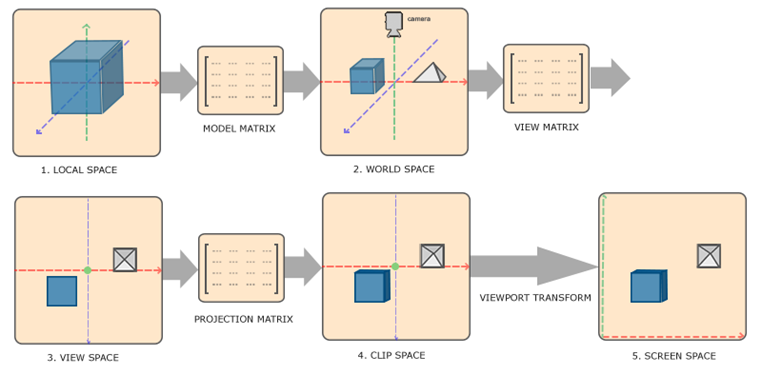Opengl_20 _复习变换矩阵+复习光源+两个模型使用不同的shader
2017-08-04 14:26
441 查看
1,
为了将坐标从一个坐标系变换到另一个坐标系,我们需要用到几个变换矩阵,最重要的几个分别是模型(Model)、观察(View)、投影(Projection)三个矩阵。

Vclip=Mprojection⋅Mview⋅Mmodel⋅Vlocal
//colors.vs
layout (location = 0) in vec3 aPos;
uniform mat4 model;
uniform mat4 view;
uniform mat4 projection;
void main()
{gl_Position = projection * view * model * vec4(aPos, 1.0);}
2,
glm::mat4 _model;
glm::mat4 _view;
glm::mat4 _projection;
_model = glm::translate(_model, glm::vec3(1.2f, 1.0f, 2.0f));
_model = glm::scale(_model, glm::vec3(0.2f));
_model = glm::rotate(_model, glm::radians(-55.0f), glm::vec3(1.0f, 0.0f, 0.0f));
_view = glm::translate(_view, glm::vec3(0.0f, 0.0f, -3.0f));
_projection = glm::perspective(glm::radians(45.0f), screenWidth / screenHeight, 0.1f, 100.0f);
glUniformMatrix4fv(glGetUniformLocation(ID, "projection"), 1, GL_FALSE, &_projection[0][0]);
glUniformMatrix4fv(glGetUniformLocation(ID, "view"), 1, GL_FALSE, &_view[0][0]);
glUniformMatrix4fv(glGetUniformLocation(ID, "model"), 1, GL_FALSE, &_model[0][0]);
3,
//两个对象使用各自的片元着色器。
//使用同一个顶端缓存表示cube模型,在设置世界空间矩阵的时候各自调整scale、translate和rotate以放在不同位置。
unsigned int VBO ;
glGenBuffers(1, &VBO);
glBindBuffer(GL_ARRAY_BUFFER, VBO);
glBufferData(GL_ARRAY_BUFFER, sizeof(vertices), vertices, GL_STATIC_DRAW);
unsigned int cubeVAO;
glGenVertexArrays(1, &cubeVAO);
glBindVertexArray(cubeVAO);
glBindBuffer(GL_ARRAY_BUFFER, VBO);
glVertexAttribPointer(0, 3, GL_FLOAT, GL_FALSE, 3 * sizeof(float), (void*)0);
glEnableVertexAttribArray(0);
// second, configure the light's VAO (VBO stays the same; the vertices are the same for the light object which is also a 3D cube)
// we only need to bind to the VBO (to link it with glVertexAttribPointer), no need to fill it; the VBO's data already contains all we need (it's already bound, but we do it again for educational purposes)
unsigned int lightVAO;
glGenVertexArrays(1, &lightVAO);
glBindVertexArray(lightVAO);
glBindBuffer(GL_ARRAY_BUFFER, VBO);
glVertexAttribPointer(0, 3, GL_FLOAT, GL_FALSE, 3 * sizeof(float), (void*)0);
glEnableVertexAttribArray(0);
4,
Shader lightingShader("colors.vs", "colors.fs");//cube shader
Shader lampShader("colors.vs", "lamp.fs");//光源shader
while (…)
{
glClearColor(0.1f, 0.1f, 0.1f, 1.0f);
glClear(GL_COLOR_BUFFER_BIT | GL_DEPTH_BUFFER_BIT);
// be sure to activate shader when setting uniforms/drawing objects
lightingShader.use();
lightingShader.setVec3("objectColor", 1.0f, 0.5f, 0.31f);
lightingShader.setVec3("lightColor", 1.0f, 1.0f, 1.0f);
lightingShader.setMat4("projection", projection);
lightingShader.setMat4("view", view);
lightingShader.setMat4("model", model);
glBindBuffer(GL_ARRAY_BUFFER, VBO);
glBindVertexArray(cubeVAO); // render the cube
glDrawArrays(GL_TRIANGLES, 0, 36);
// also draw the lamp object
lampShader.use();
lampShader.setMat4("projection", projection);
lampShader.setMat4("view", view);
lampShader.setMat4("model", model);
glBindBuffer(GL_ARRAY_BUFFER, VBO);
glBindVertexArray(lightVAO);
glDrawArrays(GL_TRIANGLES, 0, 36);
//…
}
5,
我们在现实生活中看到某一物体的颜色并不是这个物体真正拥有的颜色,而是它所反射的(Reflected)颜色。换句话说,那些不能被物体所吸收(Absorb)的颜色(被拒绝的颜色)就是我们能够感知到的物体的颜色。
如果我们将白光照在一个蓝色的玩具上,这个蓝色的玩具会吸收白光中除了蓝色以外的所有子颜色,不被吸收的蓝色光被反射到我们的眼中,让这个玩具看起来是蓝色的。
我们可以定义物体的颜色为物体从一个光源反射各个颜色分量的大小。
光色与物体颜色相乘即是反射的延伸至。
//colors.fs
out vec4 FragColor;
uniform vec3 objectColor;
uniform vec3 lightColor;
void main()
{
FragColor = vec4(lightColor * objectColor, 1.0);
}
//lamp.fs
out vec4 FragColor;
void main()
{
FragColor = vec4(1.0); // set alle 4 vector values to 1.0
}

光源其实不可见的,这里专门在光源位置画个固定白色的方块表示光源。
model = glm::translate(model, lightPos);
为了将坐标从一个坐标系变换到另一个坐标系,我们需要用到几个变换矩阵,最重要的几个分别是模型(Model)、观察(View)、投影(Projection)三个矩阵。

Vclip=Mprojection⋅Mview⋅Mmodel⋅Vlocal
//colors.vs
layout (location = 0) in vec3 aPos;
uniform mat4 model;
uniform mat4 view;
uniform mat4 projection;
void main()
{gl_Position = projection * view * model * vec4(aPos, 1.0);}
2,
glm::mat4 _model;
glm::mat4 _view;
glm::mat4 _projection;
_model = glm::translate(_model, glm::vec3(1.2f, 1.0f, 2.0f));
_model = glm::scale(_model, glm::vec3(0.2f));
_model = glm::rotate(_model, glm::radians(-55.0f), glm::vec3(1.0f, 0.0f, 0.0f));
_view = glm::translate(_view, glm::vec3(0.0f, 0.0f, -3.0f));
_projection = glm::perspective(glm::radians(45.0f), screenWidth / screenHeight, 0.1f, 100.0f);
glUniformMatrix4fv(glGetUniformLocation(ID, "projection"), 1, GL_FALSE, &_projection[0][0]);
glUniformMatrix4fv(glGetUniformLocation(ID, "view"), 1, GL_FALSE, &_view[0][0]);
glUniformMatrix4fv(glGetUniformLocation(ID, "model"), 1, GL_FALSE, &_model[0][0]);
3,
//两个对象使用各自的片元着色器。
//使用同一个顶端缓存表示cube模型,在设置世界空间矩阵的时候各自调整scale、translate和rotate以放在不同位置。
unsigned int VBO ;
glGenBuffers(1, &VBO);
glBindBuffer(GL_ARRAY_BUFFER, VBO);
glBufferData(GL_ARRAY_BUFFER, sizeof(vertices), vertices, GL_STATIC_DRAW);
unsigned int cubeVAO;
glGenVertexArrays(1, &cubeVAO);
glBindVertexArray(cubeVAO);
glBindBuffer(GL_ARRAY_BUFFER, VBO);
glVertexAttribPointer(0, 3, GL_FLOAT, GL_FALSE, 3 * sizeof(float), (void*)0);
glEnableVertexAttribArray(0);
// second, configure the light's VAO (VBO stays the same; the vertices are the same for the light object which is also a 3D cube)
// we only need to bind to the VBO (to link it with glVertexAttribPointer), no need to fill it; the VBO's data already contains all we need (it's already bound, but we do it again for educational purposes)
unsigned int lightVAO;
glGenVertexArrays(1, &lightVAO);
glBindVertexArray(lightVAO);
glBindBuffer(GL_ARRAY_BUFFER, VBO);
glVertexAttribPointer(0, 3, GL_FLOAT, GL_FALSE, 3 * sizeof(float), (void*)0);
glEnableVertexAttribArray(0);
4,
Shader lightingShader("colors.vs", "colors.fs");//cube shader
Shader lampShader("colors.vs", "lamp.fs");//光源shader
while (…)
{
glClearColor(0.1f, 0.1f, 0.1f, 1.0f);
glClear(GL_COLOR_BUFFER_BIT | GL_DEPTH_BUFFER_BIT);
// be sure to activate shader when setting uniforms/drawing objects
lightingShader.use();
lightingShader.setVec3("objectColor", 1.0f, 0.5f, 0.31f);
lightingShader.setVec3("lightColor", 1.0f, 1.0f, 1.0f);
lightingShader.setMat4("projection", projection);
lightingShader.setMat4("view", view);
lightingShader.setMat4("model", model);
glBindBuffer(GL_ARRAY_BUFFER, VBO);
glBindVertexArray(cubeVAO); // render the cube
glDrawArrays(GL_TRIANGLES, 0, 36);
// also draw the lamp object
lampShader.use();
lampShader.setMat4("projection", projection);
lampShader.setMat4("view", view);
lampShader.setMat4("model", model);
glBindBuffer(GL_ARRAY_BUFFER, VBO);
glBindVertexArray(lightVAO);
glDrawArrays(GL_TRIANGLES, 0, 36);
//…
}
5,
我们在现实生活中看到某一物体的颜色并不是这个物体真正拥有的颜色,而是它所反射的(Reflected)颜色。换句话说,那些不能被物体所吸收(Absorb)的颜色(被拒绝的颜色)就是我们能够感知到的物体的颜色。
如果我们将白光照在一个蓝色的玩具上,这个蓝色的玩具会吸收白光中除了蓝色以外的所有子颜色,不被吸收的蓝色光被反射到我们的眼中,让这个玩具看起来是蓝色的。
我们可以定义物体的颜色为物体从一个光源反射各个颜色分量的大小。
光色与物体颜色相乘即是反射的延伸至。
//colors.fs
out vec4 FragColor;
uniform vec3 objectColor;
uniform vec3 lightColor;
void main()
{
FragColor = vec4(lightColor * objectColor, 1.0);
}
//lamp.fs
out vec4 FragColor;
void main()
{
FragColor = vec4(1.0); // set alle 4 vector values to 1.0
}

光源其实不可见的,这里专门在光源位置画个固定白色的方块表示光源。
model = glm::translate(model, lightPos);
相关文章推荐
- OpenGL 入门教程 模型视图投影矩阵 变换光线
- opengl入门系列2- 模型视图矩阵变换
- OpenGL(五) 三维变换之模型视图矩阵
- 理解OpenGL中的模型视图矩阵变换
- OpenGL(五) 三维变换之模型视图矩阵
- OpenGL: 模型视图矩阵变换
- 使用全外连接比较两个数据表中的不同记录
- 矩阵及变换,以及矩阵在DirectX和OpenGL中的运用问题:左乘/右乘,行优先/列优先,...
- OPENGL 变换_视图模型变换与部分透视变换_学习笔记
- shader中法线向量为什么要乘以模型视图矩阵的逆转置矩阵
- Opengl_es模型矩阵位置:glFrustumx与glTranslatef参数的相互影响--立方体旋转特效
- 测试两个不同lua state 使用 xmove
- 使用opengl载入静态3d模型.obj的方法
- 在BlackBerry上使用OpenGL绘图(七):视图变换:观察点的运动
- 《OpenGL游戏程序设计》学习笔记---第五章坐标变换和OpenGL矩阵
- 在同一 IIS 进程中不可能运行两个不同的 ASP.NET 版本。请使用 IIS 管理工...
- 在BlackBerry上使用OpenGL绘图(六):3D变换介绍
- Win32 OpenGL编程(8) 3D模型变换及其组合应用
- 使用Log4j在系统中配置两个不同的Log输出
- Opengl_es模型矩阵位置:glFrustumx与glTranslatef参数的相互影响--立方体旋转特效
